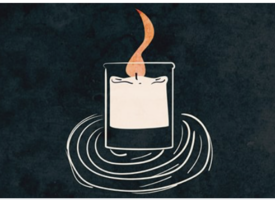"A Tale of Two Israels"
What got me finally was the selfie. While passing the bill that deprived the Supreme Court of the right to override many government decisions on the basis of “reasonableness,” coalition Knesset members crowded around Justice Minister Yariv Levin and took a selfie. Their expressions were glowing, triumphant. The men, with Levin the sole exception, wore kippot. Outside, tens of thousands of protestors reeled over the loss of the Israel they loved and had served and sacrificed for. Yet still the Knesset members beamed. Two days before Tisha B’Av, the day we remember the horrendous price of Jews hating Jews, they were celebrating their countrymen’s agony.
Everybody has a story of how they reacted to the civil turmoil ignited seven months ago by the new government’s program for judicial reform. Many took to the streets, while many more seethed at home, for or against the proposals. Some of us — and I imagine I wasn’t alone — found ourselves caught between two clashing Israels, a Jewish Scylla and Charybdis.
One of my Israels was symbolized by the boat club where I row my scull many mornings on Tel Aviv’s Yarkon River. Established by refugees from Nazi Germany in 1935, the club is a stately, wood paneled building, complete with a bar, more appropriate for Philadelphia’s Boathouse Row than Ussishkin Street. My clubmates almost invariably live in the northern part of the city and its upscale satellites. They are professionals, largely Ashkenazi, and politically left-leaning. As might be expected, a number of them demonstrated against the plan to strip the Supreme Court of its essential checks on government. At stake was their Israel: liberal, modern, open, and accepting, as normal as a Jewish state in the Middle East could possibly be. Eleven kilometers south of there, however, is my other Israel, almost a different country.
This is the Israel of my synagogue community. Mostly Mizrachi, national religious, conservative, and, to a significant degree, working class. In conversations with them and many of my neighbors, I heard repeatedly how the demonstrators did not really care about democracy — on the contrary, the government was seeking to defend the people’s choice from the encroachment of unelected, unrepresentative judges. Rather, the opposition’s goal was to preserve the power lost at the polls by the Ashkenazi elite, and to rally around the last bastion of that power, the Supreme Court.
If not intellectually, I was emotionally vised between these two Israels. During my time in Knesset, I submitted a proposal for reforming the Supreme Court. Because its judges are chosen by a committee that includes sitting justices as well as other jurists, the Court tended to perpetuate its worldview, while that of the Knesset, reflecting trends in public opinion, shifted rightward. The gap placed our two central institutions on collision course, which, I feared, could end in a Knesset override law that would effectively end judicial oversight — the pillar of just about any democratic system. My program, later incorporated into my new book, 2048: The Rejuvenated State, called for increasing the government’s ability to appoint part of the court — America was my model — and for delimiting its scope, which was the world’s widest. Democracy would be strengthened, I maintained, and judicial review upheld.
The government’s overhaul addressed many of these same issues but, fatefully, abandoned judicial review. The platform was rushed through the legislative process by a relatively slim majority representing some of the most controversial segments of Israeli society and with the support of ministers with criminal records. The coalition, I concluded, had the right idea but the wrong implementation and the wrong sponsors. At the same time, I was discomfited by the refusal of many in the opposition to consider any reform and, under any circumstances, to recognize the government’s legitimacy.
Intellectually, I knew where I stood, and called for freezing the legislative process and continuing the multi-partisan negotiations for a compromise. I feared for the precedents created by politicizing the army, the medical and business communities, and the Histadrut. I felt for those Israelis unable to get to work because of the demonstrations. I fretted over whether any of our leaders, coalition and opposition alike, could compromise with losing the support of their constituents and the respect of foreign allies. Most of all, though, I suffered over the sight of this precious country being ripped asunder by the two Israels.
I remained torn between them, tormented by the thought that they no longer shared a common lexicon much less a unified vision for our future. Both arrogated the role of democracy’s defenders and both accused the other of mounting a coup. My sole consolation lay in the belief that, at the end of the day, we are all still Israelis, still part of one people with a shared destiny and a memory of our painful past. We all remembered Tisha B’Av.
Then came that selfie. Instead of displaying humility, instead of addressing the demonstrators and saying, “Though we fervidly disagree, we both acted out of love for our country, and that love must always bind us,” the coalition members rejoiced. Rather than recalling the Jews who killed Jews inside Jerusalem while the Romans surrounded it — and the déjà vu of Israelis battling Israelis while Iran encircles us with missiles and nuclear arms — the government exulted in victory.
Though I will remain at some level trapped between those two Israels, the image of that selfie continues to haunt me. Will those religiously observant MKs fast, as is customary, on Tisha B’Av, I wonder? Will they read the Book of Lamentations, “The joy of our hearts has ceased, dancing has turned into mourning”? Or will we look back in sadness, generations from now, and ask ourselves, as our ancestors did 2,500 years ago, “Eicha” — How?















